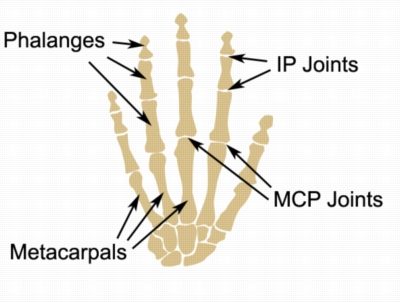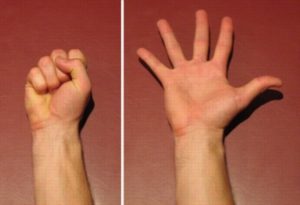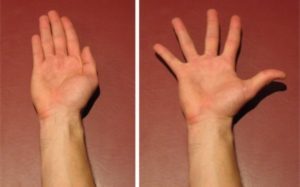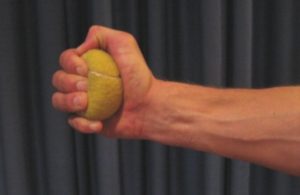Sprained Finger
Updated:
(Also known as Finger Sprain)
What is a sprained finger?
A sprained finger is a relatively common condition characterized by damage or tearing of the connective tissue (such as ligaments, cartilage and joint capsule) of one or more finger joints.
Each of the 4 fingers (excluding the thumb) comprises of 3 small bones known as phalanges. These small bones join to each other at the IP joints (Interphalangeal Joints) and to the bones of the palm (metacarpals) at the MCP joints (metacarpophalangeal joints) forming 3 joints for each finger (figure 1). Each of these joints comprises of strong connective tissue wrapping around the bony ends and cartilage which lies between the joint surfaces, cushioning the impact of one bone on another during activity.

During certain movements of the fingers, stretching or compression forces are placed on the finger joints. If these forces are excessive due to too much repetition or high force, injury to the joints may occur. This may involve damage to the cartilage or tearing to the connective tissue surrounding the joint. When this occurs, the condition is known as a sprained finger and may affect one or more IP or MCP joints.
Causes of a sprained finger
Sprained fingers are extremely common in ball sports such as basketball or netball and frequently occur due to a specific incident such as a hyperextension force (backward bending of the finger) or a sideways force. A sprained finger may also occur in contact sports due to a collision with another player or when tackling, or in martial arts or boxing (e.g. following a forceful or awkward punch). Occasionally, a sprained finger will occur due to repetitive strain associated with overuse. This may be the case in patients who perform repetitive activities involving end of range movements of the fingers.
Signs and symptoms of a sprained finger
Patients with a sprained finger often experience a sudden onset of finger pain during the causative activity. However, patients may also experience pain and stiffness after the provocative activity, particularly the next morning. Symptoms may be felt on the front, back or sides of the affected finger joint. There may be an audible snap or pop sound at the time of injury. Swelling or bruising will often develop around the affected joint. Symptoms are generally exacerbated with activities that involve use of the hand and fingers such as catching balls, opening jars or doors, writing, typing, picking up heavy objects, general gripping activity, cooking, household activities or placing weight through the affected hand and fingers. It is also common for patients to experience pain on firmly touching the affected region, and, in some cases, a feeling of weakness in the hand and fingers may also be present. In severe cases, the finger may be completely dislocated. All dislocations need to be managed by a medical professional and should be X-rayed before and after being put back into place to confirm relocation and to exclude fracture.
Diagnosis of a sprained finger
A thorough subjective and objective examination from a physiotherapist is usually sufficient to diagnose a sprained finger and to determine the likely structures affected. Investigations such as an X-ray, MRI or CT scan may be required to confirm diagnosis and rule out other injuries (particularly fractures). Generally all traumatic finger injuries should be X-rayed.
Treatment for a sprained finger
Most patients with a sprained finger make a good recovery with appropriate physiotherapy. One of the key components of treatment is that the patient rests sufficiently from ANY activity that increases their pain until they are symptom free. Protective taping or a protective brace is often required for a period of time to stabilize the joint and protect it from further damage.
Rest from aggravating activities ensures the body can begin the healing process in the absence of further tissue damage. Once the patient can perform these activities pain free, a gradual return to these activities is indicated provided there is no increase in symptoms.
Treatment of a finger sprain in the first 48 – 72 hours is vital to reduce bleeding, swelling and inflammation. This should involve following the R.I.C.E regime which comprises of rest from aggravating activities, regular icing, the use of a compression bandage and elevation of the affected limb. Anti-inflammatory medication may also be useful in this initial phase of injury and can hasten the healing process by reducing the pain and swelling associated with inflammation.
It is also important for patients with this condition to perform movement and strength exercises early in the rehabilitation process to prevent stiffness and weakness from developing and to ensure the finger is functioning correctly. These exercises should generally be implemented as soon as pain allows and should be guided by the treating physiotherapist. A gradual return to activity should occur once the patient is pain-free, provided symptoms do not increase.
Prognosis of a sprained finger
In cases of a minor to moderate finger sprain, return to sport or normal activity can usually occur in 2 – 6 weeks with appropriate management and treatment. Patients with a more severe injury will usually require a longer period of rehabilitation to gain optimum function.
Physiotherapy for a sprained finger
Physiotherapy for a sprained finger can hasten the healing process, ensure an optimal outcome and reduce the likelihood of recurrence. Treatment may comprise:
- soft tissue massage
- electrotherapy (e.g. ultrasound)
- anti-inflammatory advice
- joint mobilization
- finger taping
- finger bracing
- ice or heat treatment
- exercises to improve flexibility and strength
- education
- activity modification advice
- a gradual return to activity program
Other intervention for a sprained finger
Despite appropriate physiotherapy management, a small percentage of patients with a sprained finger do not improve adequately and require other intervention. Some patients with severe injuries may also require other intervention to ensure an optimal outcome (such as immobilization, splinting or surgery). When this occurs the treating physiotherapist or doctor can advise on the best course of management. This may involve further investigation such as an X-ray, CT scan or MRI, or a review by a specialist who can advise on any procedures that may be appropriate to improve the condition. Occasionally, surgery may be required.
Exercises for a sprained finger
The following exercises are commonly prescribed to patients with a finger sprain. You should discuss the suitability of these exercises with your physiotherapist prior to beginning them. Generally, they should be performed 3 times daily and only provided they do not cause or increase symptoms.
Hand Open and Close
Curl your fingers and thumb making a tight fist then straighten your fingers as far as possible pain-free (figure 2). Repeat 10 times provided there is no increase in symptoms.

Finger Adduction to Abduction
Begin this exercise with your fingers together as demonstrated (figure 3). Spread your fingers apart as far as possible pain-free then return to the starting position. Repeat 10 times provided there is no increase in symptoms.

Tennis Ball Squeeze
Begin this exercise holding a tennis ball (figure 4). Squeeze the tennis ball as hard as possible and comfortable without pain. Hold for 5 seconds and repeat 10 times provided there is no increase in symptoms.

 Physiotherapy products for a sprained finger
Physiotherapy products for a sprained finger
Some of the most commonly recommended products by physiotherapists to hasten healing and speed recovery in patients with this condition include:
To purchase physiotherapy products for a sprained finger click on one of the above links or visit the PhysioAdvisor Shop.
 Find a Physio for a sprained finger
Find a Physio for a sprained finger
Find a physiotherapist in your local area who can treat this condition.
 More Information
More Information
- View more Hand & Finger Flexibility Exercises.
- View more Hand Strengthening Exercises.
- View Finger Taping Techniques.
- View Hand & Wrist Pain Diagnosis

Link to this Page
If you would like to link to this article on your website, simply copy the code below and add it to your page:
<a href="https://physioadvisor.com.au/injuries/wrist-hand/sprained-finger”>Sprained Finger – PhysioAdvisor.com</a><br/>PhysioAdvisor offers detailed physiotherapy information on a sprained finger including: causes, symptoms, diagnosis, treatment, exercises, physiotherapy products and more...
Return to the top of Sprained Finger.


